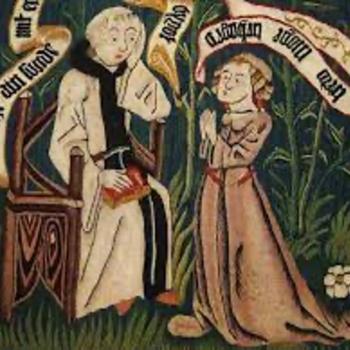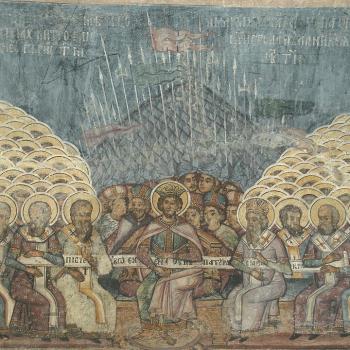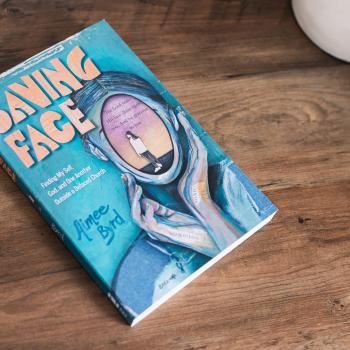 In 2012, Rachel Held Evans—a New York Times bestselling author of American Christianity–wrote a stunningly provocative book titled A Year of Biblical Womanhood. In it, she vividly shows us how “biblical womanhood” is not a constant. It is a culturally constructed concept. For those of you unfamiliar with her book, she spent a year living out as many different versions of “biblical womanhood” as she could find throughout the Old and New Testament—from sleeping in a tent in her front yard during her period to covering her head and remaining silent at church. Her book really helped me understand how biblical womanhood, to at least some degree, is in the eye of the beholder.
In 2012, Rachel Held Evans—a New York Times bestselling author of American Christianity–wrote a stunningly provocative book titled A Year of Biblical Womanhood. In it, she vividly shows us how “biblical womanhood” is not a constant. It is a culturally constructed concept. For those of you unfamiliar with her book, she spent a year living out as many different versions of “biblical womanhood” as she could find throughout the Old and New Testament—from sleeping in a tent in her front yard during her period to covering her head and remaining silent at church. Her book really helped me understand how biblical womanhood, to at least some degree, is in the eye of the beholder.
Today, the ideas we associate with biblical womanhood —you know, the ones you hear from Lisa Teurkherst on KLove’s Proverbs 31 Woman and Desiring God podcasts that emphasize women as submissive wives who prioritize children and home over career and who are content to teach children at church but remain under the patriarchal hierarchy of male teachers and pastors—are emphasized by modern American culture NOT because they are “biblical” but because they are culturally acceptable. We (as Evangelical Christians) have chosen to focus on these aspects of biblical womanhood (which also means we have chosen to ignore other characteristics associated with biblical women).
Yet this idea that “biblical womanhood” owes as much (if not more) to cultural invention than it does to biblical text has made little headway among evangelical Christians. Indeed, it often seems that the opposite has happened—rather than a cultural construction, “biblical womanhood” is viewed as integral to normative Christianity. In a 2012 interview, for example, John Piper, Denny Burke, and Tim Keller argued that male headship and female submission is not a secondary issue; it is a gospel issue. Keller argued that complementarianism, the view that God designed distinct roles for men and women in both biology and personhood, “indirectly affects the way we understand scripture and the way we understand the gospel.” Piper cut to the chase, stating the “men are wired to lead,” and if Christians “aren’t willing to stand against the tide” of culture on this issue (i.e. support complementarianism and reject egalitarianism), “you are probably going to cave on some other important issues.”
In other words, what you believe about male headship and female submission is a litmus test for orthodoxy.
Those who support more egalitarian readings of scripture, Piper suggests, are more likely to compromise the gospel. Those who accept “biblical womanhood,” in contrast, are more likely to be theologically sound.
Men lead; women follow. The Bible (not just a particular interpretation of some biblical texts; but The Bible) tells us so. Just a few days ago, on April 27, Desiring God posted this remark by John Piper on Facebook: “Leadership is taking initiative. Who says, ‘Let’s . . . ’ more often in your relationship? ‘Let’s go out to eat.’ ‘Let’s try to get our finances in order.’ ‘Let’s get to church on time next Sunday.’ Who says it most often? If it’s the wife, you have a problem, and the problem is with the guy. If it’s the guy, she’s probably happy, because she doesn’t want to be the one to say ‘let’s’ over and over again. In general, leadership means a bent toward initiative under which women thrive.” This post got 1.7 thousand responses, mostly ‘likes’ and ‘loves’. It was shared 430 times (at my last count). While I can’t prove that most of these likes and loves were evangelical Christians, I am probably right that they are.
Conservative evangelical Christians support male headship and associate ‘biblical womanhood’ with marriage, family, and submission.
As I have argued in previous posts (Paul on Women: A Modern Obsession? and Paul Interrupted: A Medieval Perspective), only a handful of verses are used to define this notion of biblical womanhood: 1 Corinthians 11 and 14, Ephesians 5, 1 Timothy 2, Colossians 3. These verses have become increasingly popular since the 1950s. They also have been increasingly used as the primary lens through which conservative Christians view women.
Yet, as I have also argued in a previous post, the emphasis on Paul’s writings about women—specifically 1 Corinthians 11 & 14, Colossians 3, Ephesians 5, and 1 Timothy 2—has been far less consistent throughout church history than modern scholars and even modern Christians would like to think. Evidence from vernacular sermons in late medieval England shows that Paul’s writings about women have not always been in the forefront of Christian thought. Nor have they always been applied to limit female authority.
This lack of concern for either emphasizing female subordination or arguing against female leadership becomes even more apparent when we turn to The Book of the Saints of the Ethiopian Church. This collection of over 1000 saints lives, compiled probably in the thirteenth century, and created to be read regularly during church services, has remained a significant part of Ethiopian Christianity since the medieval era. Scripture is regularly woven into the stories of the saints, including at least thirty-two specific references to Paul and Pauline writings. From stories about Paul in Acts to scripture incorporated from Corinthians, Galatians, Timothy, Romans, etc., the writings of Paul form both a familiar and a critical part of this religious text. Like the sermons in late medieval England, The Book of the Saints of the Ethiopian Church is absolutely silent on the Pauline scripture referencing female subordination and limiting female authority. It is simply not there.
What is there, however, is clear support for women exercising leadership roles in medieval Ethiopian Christianity.
This week I am going to give you just two examples (both from The Book of the Saints of the Ethiopian Church). The first is the story of a woman named Thecla. She lived in Macedonia during the first century and heard Paul preach what seems to be a part of the Sermon on the Mount. “Blessed are those who are poor for righteousness’ sake, for theirs is the kingdom of heaven. Blessed are those who mourn here for they shall rejoice. Blessed are those who are persecuted for righteousness’ sake, for theirs is the kingdom of heaven.” When Thecla heard these words, she converted to Christianity, and snuck out to meet Paul. Paul welcomed her, absolutely unconcerned about her female body or her female personhood (she definitely wasn’t adhering to modern notions of “biblical womanhood”), and taught her. When her parents and the government tried to arrest her for illegally converting to Christianity, she miraculously escaped and ran off to join Paul. He again took her in. Just as Jesus welcomed Mary of Bethany and taught her like a man (she sat at the feet of the teacher and ignored her household responsibilities) even though she was a woman, Paul welcomed Thecla. She followed him, learned from him, performed miracles, and–in the words of the text—preached in the Name of the Lord Jesus Christ. This is exactly the phrase used to describe Paul’s preaching—“he began to preach in the Name of the Lord Jesus Christ.” Thecla “continued to follow Paul, and to preach in the Name of Our Lord Jesus Christ.” Instead of quoting women be silent or women should not exercise authority over men, The Book of the Saints of the Ethiopian Church affirms a woman as a disciple of the Apostle Paul, as a preacher in exactly the same way as the Apostle Paul, and as a leader of the early church in her own right.
If God created women distinct in biology and personhood (designed to perform different roles from men, especially in regards to family and leadership), why could Thecla defy her family and be trained by Paul to become a leader in the early church—disciple, missionary, preacher? Moreover her story was used as an exemplar for both women and men in medieval Ethiopia. The text makes no indication that she was to be considered anomalous. In fact, it doesn’t really matter to the text that she was a woman. Rather it was her conversion, devotion, and leadership. Biblical womanhood?
My second story likewise advances a different picture of biblical womanhood. This time, the woman is a mother, but she defies the authority of her husband, becomes the faith leader in her own family (sorry Focus on the Family…), and overturns the authority of a priest. The story is of a holy saint named Sara from Antioch. Her husband was a governor of Diocletian. His family converted to Christianity, but when the emperor confronted him, the man became an apostate. He told his wife, “I love the Faith of Christ, but I denied Him, because I am afraid of the emperor’s torturings.” Sara, however, did not follow in her husband’s footsteps. She became increasingly concerned about the salvation of her sons, especially given the example of their father. So she ran away with them–heading to Alexandria to find the Archbishop Peter with the hope of asking him to baptize her sons. On the way, however, a terrible storm struck and their ship began to sink. The woman prayed for God to help her. Then she took a razor, slit her breast, and used her own blood to anoint her sons with the sign of the Cross. She then dipped them three times over the side of the ship into the sea, proclaiming their baptism in the “Name of the Father and the Son and the Holy Spirit.” The sea immediately grew calm. After arriving at Alexandria, the woman took her children to the Archbishop. He was administering a large baptism, and so pulled her boys into the line. Funny enough, however, when he tried to dip them into the font, the water congealed. He was confused. So he tried again. The same thing happened. Finally, he brought Sara in for questioning. She confessed that she, as a woman, had already baptized her sons (not to mentioning performing a miracle by calming the sea). She begged for forgiveness, presumably for taking over the role of a priest. The Archbishop, however, refused her confession. She had done nothing wrong. As he said, “Fear not, for it is our Lord Jesus Christ Who hath baptized thy sons, with His own hand, when thou didst immerse them in the sea.” Interestingly, the language the priest used is very similar to an ancient text called the Didascalia (which authorizes the role of deaconess). It stated that deacons stood in for Jesus Christ. In the same way, this woman stood in for Jesus Christ and her baptism was accepted as efficacious.
These medieval religious stories from Ethiopia absolutely ignored the Pauline proscriptions and household codes.
Instead of emphasizing female subordination, they emphasized women in leadership roles—as teacher, as preacher, as baptizer.
Complementarian definitions about “biblical womanhood” are strangely absent from The Book of the Saints of the Ethiopian Church.
Could it be that the complementarian notion of “biblical womanhood” (especially the claim that women’s distinct personhood makes no room for women as teachers and leaders of men) is not only more recent but also a more Western perspective? Could our modern notion of “biblical womanhood”, which confines women’s primary role to house and family and forbids women all leadership roles over men in the church, have less to do with the Bible and more to do with American Christianity?
Think about it.
Stay tuned for next time as I wrap up my series on Paul and draw once more from World Christianity.
This post is dedicated to Anna Redhair. Anna graduates next week with her MA in History from Baylor. I had the privilege of directing her thesis, which introduced me to Ethiopian Christianity.













